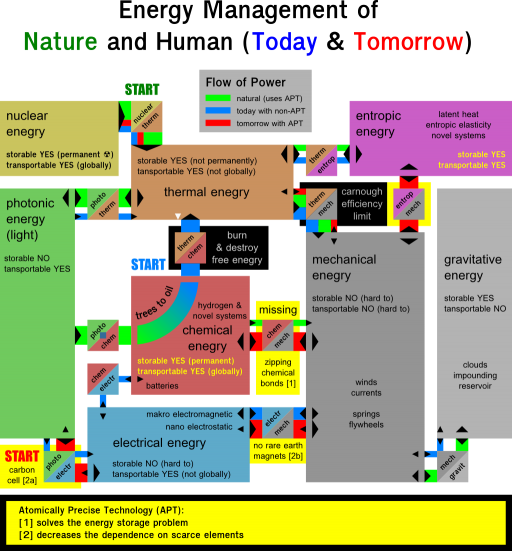Energy conversion
Atomically precise technology for energy conversion can:
- solve the enegry storage problem making renewable energy storable and fossile or nuclear fission baseload power plants unnecessary
- circumvent burning processes that unnecessarily devaluates energy
Different power-converter-systems have system-heterogeneity residing on different system-size-scales.
(wiki-TODO: Make a table listing all the possible combinations for quick overview and access)
Contents
Nanoscale: molecular power converters
AP technology provides several possibilities for energy conversion that work in a mill/zip/conveyor belt like style:
Chemomechanical conversion
See main page: Chemomechanical converters
This is the link for massive and efficient energy storage that is missing today (2021).
Electromechanical conversion
See main page: Electromechanical converters
Basically nanoscale electro moters that work electrostatically rather than magnetostatically as macroscale electromotors do.
Also a possibility: Transporting bond charges.
This might be useful for high voltage low current applications.
Much less lopsided than with macroscale electrostaic generators though.
Similar to a pelletron or a
Wimshurst machine
but with very different performance characteristics.
Optoelectrical conversion (future)
See main page: Diamondoid solar cells
Part of the non mechanical technology path
This is basically about good old solar cells.
But when there is already atomically precise available that gives us control over matter beyond mere thermodynamic means.
Electrocemical conversion (future)
This is basically about good old batteries.
But when there is already atomically precise available that gives us control over matter beyond mere thermodynamic means.
Direct electromagnetic wave to mechanical conversions
- mechanoradio and radiomechanical conversion
– spinning electrical dipoles really fast mechanically
– the limit might be somewhere at 100GHz? (nanoscale levitation likely needed to limit friction at speeds close to the unsupported rotating ring speed limit) - mechanooptical conversion – this is very new – exciting elecronic stated by force applying mechanic manipulation on bound molecules
- optomechanical conversion – basically photochemistry – causing a conformational change through electronic structure change through optical excitation
The teraherz gap between radio frequencies and far infrared frequencies
- is too high for generation by moving charges mechanically and also
- is challenging to cover even from the electronic side – (non mechanical technology path)
Mesoscale
All thermo involving energy conversion processes are at least mesoscale since thermal isolation is needed
and thermal isolation does not work well at the nanoscale due to the large surface to volume ratios that are present there (scalng law).
Entropomechanical conversion
See main page: Entropomechanical converters
This is about storing energy
- into molecular order
- into squeezing out molecular degrees of freedom
and then when needed releasing it again.
Releasing energy sucks up microstates from the thermal path to put them into microstates in spacial disorder.
things cool down making this a very safe way of storing energy.
No big booms and fireballs. Even in worst case scenarios.
Thermomechanical concerters
- thermomechanical converters – (diamondoid heat pump systems)
Used base technologies for such heat pump systems can be:
Note that although the efficiency of heat pumps is fundamentally limited by the Carnough-cycle
the conversion can be near reversible given thermal isolation is really good.
Thermoentropic converters
That's basically storing thermal energy into phase changes.
Existing technology. We'ss see how gem-gum technology can improve on that.
Thermoelectric converters
These fall squarely under the non mechanical technology path.
Reaching high efficiencies is difficult.
We'll see what we can do once we can make much more materials via piezochemical mechanosynthesis
beyond the very limited set of accessible structures that we can reach today with only thermodynamic means.
Macroscale
Thermonuclear conversion (or rather nuclearthermo conversion)
Complex macroscopic systems made from advanced diamondoid metamaterials may lead to significant improvements here.
See main page: APM and nuclear technology
- There are some exotic approaches for partially direct nuclearelectric conversion perhaps allowing to go beyond the Carnough limit in efficiency.
- Direct nuclearmechanical seems not possible or sensible.
Gravomechanical conversion
Given gravity is a macroscopic phenomenon the technology is inherently macroscopic.
Nothing much new here with gem-gum technology.
Well space elevators maybe. But these are difficult.
Related
External links
- Wikipedia: transducer, actuators, ...
